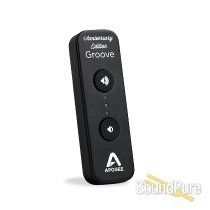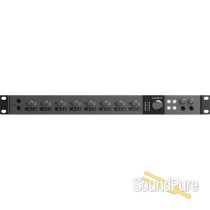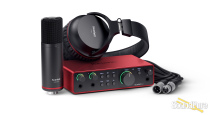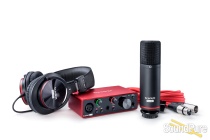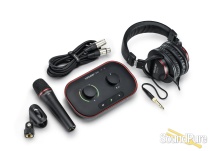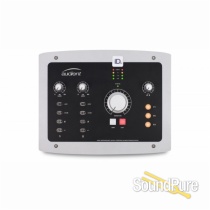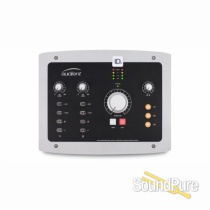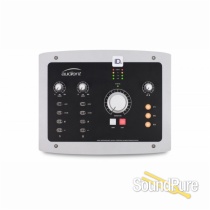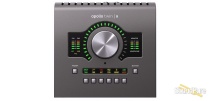-
Call Us Toll Free888-528-9703
-
Local/International (+1)919-682-5552
- Call Us! Toll Free! 888-528-9703
- Local / International (+1) 919-682-5552

RME Fireface 400 FireWire Audio Interface From RME
32 Channel, 24 Bit, 192kHz Bus-Powered FireWire Audio Interface
Manufacturer's Description from RME
RME's Fireface 800 revolutionized the world of FireWire audio interfaces. Now the revolution continues: The Fireface 400 is not just the little brother of the Fireface 800 - it is a completely newly designed device. It is the only device in its class with active jitter suppression, stand-alone functionality, complete controllability from the front panel, highly flexible I/Os in professional quality, and an unsurpassed 648-channel matrix router - at sample rates up to 192 kHz.
As usual, RME offer a host of sophisticated features and characteristics. These include:
Two digitally controlled Mic Preamps in high-end quality
Two balanced universal inputs for line and instrument signals
SteadyClock for maximum jitter suppression and clock refresh
Simple stand-alone operation with rotary encoder and front panel display 54 Level Meter Peak/RMS, hardware-calculated
Full mobility by Bus Power support DIGICheck, RME's unique meter and analysis tool
TotalMix: 648-channel mixer with 42-bit internal resolution
The DSP-based TotalMix mixer allows fully independent routing and mixing of all 18 input and output channels to all 18 physical outputs. Up to 9 totally independent stereo sub-mixes simply mean unrivalled monitoring facilities. Copy/paste of routings, ganging and group-based operation of faders, and the extraordinary Matrix window are just some of the mixer's unique features. The mixer can be completely MIDI controlled, even in stand-alone operation. Furthermore the DSP hardware calculates RMS and Peak levels for all 54 audio channels, without causing any significant CPU load.
A word clock input and output (BNC) plus two MIDI I/Os (breakout cable, 5-pin DIN) complete the analog/digital feature list and turn the Fireface 400 into an entire audio system of the highest quality.
The Fireface 400 excells as portable all-in-one solution when it comes to power supply. The included switching power supply accepts voltages from 100 to 240 V, thus can be operated all over the world. A rear panel switch enables Bus Powered operation, taking the power directly from the FireWire connector. To avoid potential problems, both the unit's internal power supply and the protective circuits at the FireWire port were specially designed and thoroughly tested.
Analog I/Os
Eight inputs and outputs (balanced, output 7/8 unbalanced) with software controlled switching of the reference levels (-10 dBV, +4 dBu, Lo/HiGain), of course realized discretely in the analog domain, guarantee highest dynamic range and highest fidelity.
The Fireface 400's front panel features 2 balanced microphone inputs with a digitally controlled input stage, individually switchable 48V phantom power, and Neutrik Combo connectors for XLR and TRS. These can also be used as additional line inputs. A pre amplification of up to 65 dB, adjustable in steps of 1 dB over a range of 55 dB, exceptional EIN performance even at low pre-amplification settings, and extremely low THD+N let these preamps surpass those of other devices that cost several times the price of the Fireface 400. All level settings are 100% reproducible and can also be adjusted by software comfortably.
Inputs 3 and 4 are extremely flexible balanced universal inputs. Firstly, they operate exactly as inputs 5 to 8 on the rear and can be adjusted to accept standard studio input levels (+4 dBu, LoGain). Furthermore, the input impedance can be switched from Line (10 kOhm) to Instrument (470 kOhm). An additional analog input amplification of up to 18 dB (in steps of 0.5 dB) is also available. In short: There's no signal that these inputs can't deal with perfectly!
Inputs 5 to 8 on the rear feature RME's proven level references. -10 dBV, +4 dBu und Lo Gain can be selected in the settings dialog, equivalent to +2 dBV, +13 dBu und +19 dBu for digital full scale. The same applies to the balanced rear analog outputs 1 to 6. The high power phones output offers high volumes even with low-impedance headphones, and represents playback channels 7/8. All outputs can be used for ASIO Direct Monitoring purposes.
Digital I/Os
An ADAT optical I/O allows for a connection and insertion of effects devices, mixing consoles or external converters. Of course, these 8 channels are available simultaneously with the analog channels. Using an additional ADI-8 DS or OctaMic D, you'll get 16 analog inputs and outputs, which remain still 12 at 96 kHz. The coaxial SPDIF I/O, which is fully AES/EBU compatible (as is common for RME), also works up to 192 kHz, which means that at the highest sample rate, 8 analog and two digital inputs and outputs are directly available. SPDIF can also be accessed through the optical I/O, which also works up to 192k - a world exclusive RME feature.
Features
Thanks to an internal flash memory, all settings including TotalMix are recalled during boot. The device can thus be configured and used as a stand-alone device, without being connected to a computer, e.g. as a submixer, A/D and D/A-converter, headphone mixer, format converter, instrument or microphone pre-amplifier, monitoring mixer and much more.
The Fireface 400 is equipped with SteadyClock, RME's unique sync and clock technology. With this, the device becomes a sync reference for the whole studio. SteadyClock refreshes clock signals, removes jitter, and takes permanent care of optimal conversion quality, thus guarantees a sensational sound quality, completely independent from the reference clock's quality.
SteadyClock allows the unit to control the sample rate freely on its own. The Settings dialog includes a direct choice of the video and audio world's most often used sample rates. Additionally, two faders can be used to set the sample rate freely and in real-time, within the range of +/- 4% and +/- 0.4%.
Fireface 400 uses RME's own FireWire techology, heavily optimized for audio purposes (RME is the only manufacturer not to use a third party FireWire audio technology). Minimum overhead, special hardware adaptations, and a new low-latency buffer concept allow a performance and compatibility considered impossible for FireWire audio until now. This includes changing latency in mid-operation, latencies down to one ms, or an immediate reaction to changes of the sample rate. Further optimizations and additional features can be added at any time by Flash Updates.
Of course the Fireface 400 offers a second FireWire port for hub functionality. Several devices can be connected to one FireWire interface and operated in parallel. The renowned Fireface 800 shares the same driver, allowing mixed setups.
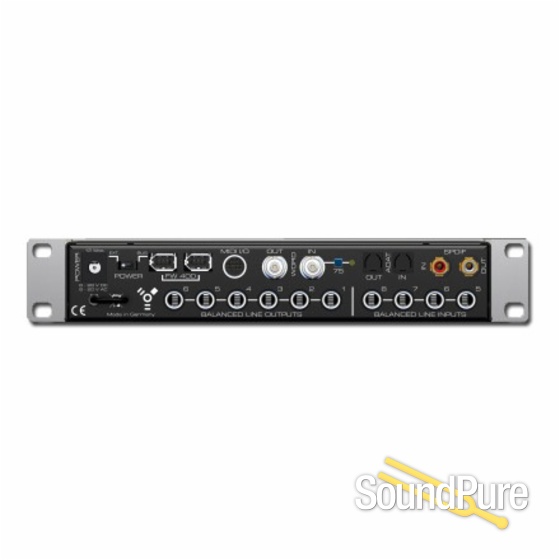
About Manufacturer
RME is a young German team of developers with a robust vision of creating innovative, user friendly, and high-quality digital audio solutions for less money. Founded in 1996, RME quickly earned their stripes as a premiere industry provider, expanding rapidly into mainstream international markets. Each developer on the RME team is either a musician or sound engineer - besides being a specialist in hardware and software development. Additionally, to give their designs a persistent competitive edge in today's market, RME developers regularly network with other industry specialists to exchange knowledge and information - truly designing a line of products with superior quality, and affordable, mass-market appeal. RME has had a consistent string of successful product releases, earning awards and accolades from the press and the public alike. The enthusiastic response and worldwide support the RME product line has generated ranks them one of the top audio device companies in the industry.
Specifications
Input AD: 6 x 1/4" TRS (4 x LIne, 2 x Line/Instrument), 2 x XLR/TRS Combo connector (2 x Mic/Line) all servo-balanced.
Output DA: 6 x 1/4" TRS, servo-balanced, DC-coupled signal path. 1 x 1/4" TRS unbalanced
Input Digital: 1 x ADAT optical or SPDIF optical, SPDIF coaxial (AES/EBU compatible)
Output Digital: 1 x ADAT optical or SPDIF optical, SPDIF coaxial (AES/EBU compatible)
MIDI: 2 x MIDI I/O via breakoutcable (4 x 5-pin DIN jacks), for 32 channels low jitter hi-speed MIDI
Dynamic range AD: 109 dB RMS unweighted, 112 dBA
THD AD: < -100 dB (< 0.001 %)
THD+N AD: < -98 dB (< 0.0012 %)
Crosstalk AD: > 100 dB
Dynamic range DA: 110 dB RMS unweighted, 112 dBA (unmuted)
THD DA: < -100 dB (< 0.001 %)
THD+N DA: < -97 dB (< 0.0014 %)
Crosstalk DA: > 100 dB
Input/Output level for 0 dBFS @ Hi Gain: +19 dBu
Input/Output level for 0 dBFS @ +4 dBu: +13 dBu
Input/Output level for 0 dBFS @ -10 dBV: +2 dBV
Sample rate internally: 32, 44.1, 48, 64, 88.2 kHz, 96 kHz, 128, 176.4, 192 kHz
Sample rate externally: 28 kHz - 200 kHz
Frequency response AD/DA, -0.5 dB: 5 Hz - 21 kHz (sf 44.1 kHz)
Frequency response AD/DA, -0.5 dB: < 5 Hz - 43.3 kHz (sf 96 kHz)
Frequency response AD/DA, -1 dB: < 5 Hz - 70 kHz (sf 192 kHz)



